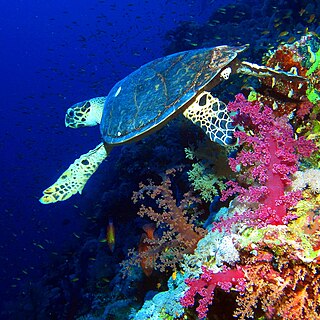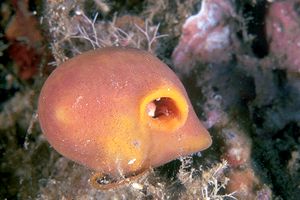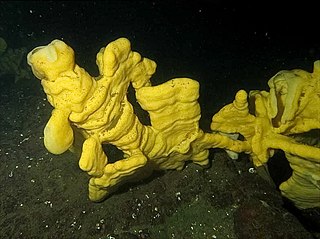Related Research Articles

Sponges, the members of the phylum Porifera, are a basal animal clade as a sister of the diploblasts. They are multicellular organisms that have bodies full of pores and channels allowing water to circulate through them, consisting of jelly-like mesohyl sandwiched between two thin layers of cells.

The Venus' flower basket is a glass sponge in the phylum Porifera. It is a marine sponge found in the deep waters of the Pacific ocean, usually at depths below 500 meters. Like other sponges, they feed by filtering sea water to capture plankton and marine snow. Similar to other glass sponges, they build their skeletons out of silica, which forms a unique lattice structure of spicules. The sponges are usually between 10 cm and 30 cm tall, and their bodies act as refuge for their mutualist shrimp partners. This body structure is of great interest in materials science as the optical and mechanical properties are in some ways superior to man-made materials. Little is known regarding their reproduction habits, however fluid dynamics of their body structure likely influence reproduction and it is hypothesized that they may be hermaphroditic.

Demosponges (Demospongiae) are the most diverse class in the phylum Porifera. They include 76.2% of all species of sponges with nearly 8,800 species worldwide. They are sponges with a soft body that covers a hard, often massive skeleton made of calcium carbonate, either aragonite or calcite. They are predominantly leuconoid in structure. Their "skeletons" are made of spicules consisting of fibers of the protein spongin, the mineral silica, or both. Where spicules of silica are present, they have a different shape from those in the otherwise similar glass sponges. Some species, in particular from the Antarctic, obtain the silica for spicule building from the ingestion of siliceous diatoms.

A spongivore is an animal anatomically and physiologically adapted to eating animals of the phylum Porifera, commonly called sea sponges, for the main component of its diet. As a result of their diet, spongivore animals like the hawksbill turtle have developed sharp, narrow bird-like beak that allows them to reach within crevices on the reef to obtain sponges.

Suberites domuncula is a species of sea sponge belonging to the family Suberitidae.

The cloud sponge(Aphrocallistes vastus) is a species of sea sponge in the class Hexactinellida. It is a deep-water reef-forming animal. The species was first described by F.E. Schulze in 1886.

Spicules are structural elements found in most sponges. The meshing of many spicules serves as the sponge's skeleton and thus it provides structural support and potentially defense against predators.

Suberites is a genus of sea sponges in the family Suberitidae. Sponges, known scientifically as Porifera, are the oldest metazoans and are used to elucidate the basics of multicellular evolution. These living fossils are ideal for studying the principal features of metazoans, such as extracellular matrix interactions, signal-receptor systems, nervous or sensory systems, and primitive immune systems. Thus, sponges are useful tools with which to study early animal evolution. They appeared approximately 580 million years ago, in the Ediacaran.

Spongilla lacustris is a species of freshwater sponge from the family Spongillidae. It inhabits freshwater rivers and lakes, often growing under logs or rocks. Lacustris is a Latin word meaning "related to or associated with lakes". The species ranges from North America to Europe and Asia. It is the most common freshwater sponge in central Europe. It is the most widespread sponge in Northern Britain, and is one of the most common species of sponges in lakes and canals. Spongilla lacustris have the ability to reproduce both sexually and asexually. They become dormant during winter. The growth form ranges from encrusting, to digitate, to branched, depending upon the quality of the habitat.

Euplectella is a genus of glass sponges which includes the well-known Venus' Flower Basket. Glass sponges have a skeleton made up of silica spicules that can form geometric patterns. These animals are most commonly found on muddy sea bottoms in the Western Pacific and Indian Oceans. They are sessile organisms and do not move once attached to a rock. They can be found at depths between 100 m and 1000 m but are most commonly found at depths greater than 500 m.

Callyspongia (Cladochalina) aculeata, commonly known as the branching vase sponge is a species of Porifora, meaning sea sponge, in the family Callyspongiidae. Poriferans are typically characterized by ostia, pores that filter out plankton, with an osculum as the opening which water leaves through, and choanocytes trap food particles.
Homaxinella balfourensis is a species of sea sponge in the family Suberitidae. It is found in the seas around Antarctica and can grow in two forms, either branching out in one plane like a fan or forming an upright club-like structure.

Poribacteria are a candidate phylum of bacteria originally discovered in the microbiome of marine sponges (Porifera). Poribacteria are Gram-negative primarily aerobic mixotrophs with the ability for oxidative phosphorylation, glycolysis, and autotrophic carbon fixation via the Wood – Ljungdahl pathway. Poribacterial heterotrophy is characterised by an enriched set of glycoside hydrolases, uronic acid degradation, as well as several specific sulfatases. This heterotrophic repertoire of poribacteria was suggested to be involved in the degradation of the extracellular sponge host matrix.

Until the late 1950s, the Precambrian was not believed to have hosted multicellular organisms. However, with radiometric dating techniques, it has been found that fossils initially found in the Ediacara Hills in Southern Australia date back to the late Precambrian. These fossils are body impressions of organisms shaped like disks, fronds and some with ribbon patterns that were most likely tentacles.

Geodia barretti is a massive deep-sea sponge species found in the boreal waters of the North Atlantic Ocean, and is fairly common on the coasts of Norway and Sweden. It is a dominant species in boreal sponge grounds. Supported by morphology and molecular data, this species is classified in the family Geodiidae.

Silicateins are enzymes which catalyse the formation of biosilica from monomeric silicon compounds extracted from the natural environment. Environmental silicates are absorbed by specific biota, including diatoms, radiolaria, silicoflagellates, and siliceous sponges; silicateins have so far only been found in sponges. Silicateins are homologous to the cysteine protease cathepsin.
Claviscopulia is a genus of glass sponge in the family Farreidae.

Bolosoma is a genus of pedunculated siliceous sponges belonging to the family Euplectellidae. This genus lives in deep-sea environments and provides a habitat for a plethora of other benthic species, giving Bolosoma an incredibly important ecological role in the ecosystems it is a part of.
Diapleuridae is a family of five extinct species of marine glass sponges found in the Caribbean Sea, Florida Straits, Banda Sea, and US Virgin Islands. A sixth species–Diapleura hatoni–is postulated to have existed around the same time as the other five, but there is limited research on it. Diapleuridae is part of class Hexactinellida and order Lyssacinosida. These sponges lived during the Middle Epoch of the Eocene and were filter feeders that were attached to the benthos by a basal disc. The oldest recorded fossil of a species of Diapluridae is from 47.8 million years ago, with the most recent fossil dated 41.3 million years ago.

Monanchora is a genus of demosponges belonging to the family Crambeida. The genus contains 18 species, which have been researched for their potential use in medicine.
References
- 1 2 Maldonado, Manuel; Riesgo, Ana (2007-06-01). "Intra-epithelial spicules in a homosclerophorid sponge". Cell and Tissue Research. 328 (3): 639–650. doi:10.1007/s00441-007-0385-7. ISSN 1432-0878.
- 1 2 Sogabe, Shunsuke; Hatleberg, William L.; Kocot, Kevin M.; Say, Tahsha E.; Stoupin, Daniel; Roper, Kathrein E.; Fernandez-Valverde, Selene L.; Degnan, Sandie M.; Degnan, Bernard M. (June 2019). "Pluripotency and the origin of animal multicellularity". Nature. 570 (7762): 519–522. doi:10.1038/s41586-019-1290-4. hdl: 10023/19125 . ISSN 0028-0836.
- ↑ "28.1: Phylum Porifera". Biology LibreTexts. 2015-11-02. Retrieved 2020-12-03.